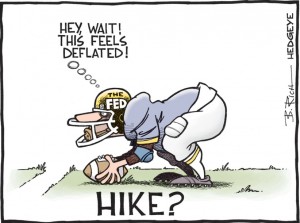History is no guide to the impact of the anticipated rate hike by the Federal Reserve. But why do we watch this activity anyway? We watch the Fed because everyone watches the Fed because we watch the Fed. Circles.
It has been so long since the Federal Reserve raised interest rates that US stock market investors probably should not look to past rate hike cycles for clues about potential winners and losers. But investors do expect more rapid-fire moves from one stock market sector to another, based on what happened throughout 2015 when comments from Janet Yellen or other Fed officials changed expectations of central bank moves multiple times.
Stock market investors are ready for the first U.S. Federal Reserve interest rate hike in nearly a decade next week, but they may not be fully prepared for all of the nuanced remarks likely to accompany that announcement.
If the Fed lays out an aggressive schedule of future rate increases, stock markets could become very volatile and even plummet, say strategists who expect a market-calming central bank announcement detailing the patience of policymakers.
Activity in the options market suggests stock traders are being cautious ahead of the Fed policy meeting and options expiring at the end of next week could amplify volatility in either direction.
That could partly explain the jittery trading on Wall Street,during which volatility has risen and the benchmark S&P 500 dropped 3.5 percent.
A slew of economic data due to be released before the Fed meeting, including readings on growth in manufacturing, industrial production and consumer prices, could cause some choppiness if traders take any robust data as a sign that the Fed may be more aggressive with future rate increases.
Furthermore, markets could face an interruption next week if Congress and President Barack Obama trigger a government shutdown by failing to finish work on a $1.5 trillion government funding bill.
That uncertainty has helped trigger bets in the options market by investors trying to cover themselves against a wide array of outcomes in stocks, and similar uncertainty has been apparent across other asset classes as well.
Crude oil futures fell to seven-year lows while the euro, expected to decline against the dollar as the Fed tightens, rallied after many covered those bets. Positioning is leaning more heavily toward seeking protection against a broad stock market move lower, said traders who expect volatility to spike after the Fed meeting..
The CBOE Volatility Index .VIX, the market’s favored barometer of trader angst, has crept over its long-term average of 20, after having stayed mostly below that level since early October. On Friday, it was up 28 percent at 24.72.
That level is higher than futures show the VIX going forward, signifying that traders are more worried about near-term volatility than they are about a long-term breakdown.
But a sharp move to the downside could be amplified since the Fed decision comes just two days ahead of “quadruple-witching,” when options on stocks and indexes and futures on indexes and single-stocks all expire, making the index particularly prone to a jump in volatility.

